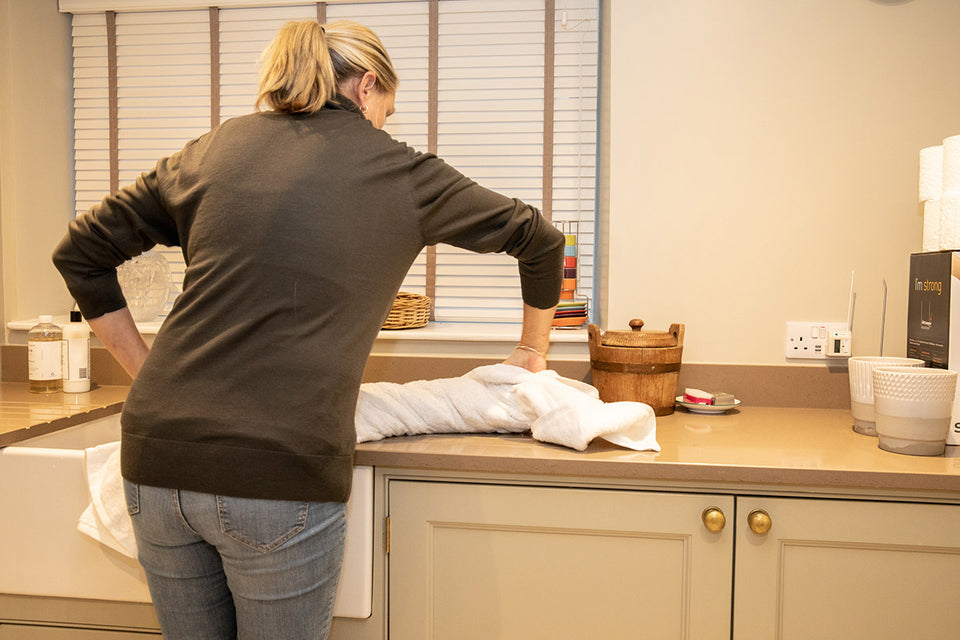Since satin is a delicate material it's important to know how to clean satin properly and extend its life in that way. Learn how to preserve your favorite satin items by reading our guide.
Next to flowers and a cake, one of the ingredients you are likely to find at any wedding is satin. Satin wedding dresses, satin shoes, satin table linens.
Even Spanish fashion designer Manolo Blahnik said, “I’m mad for satin.”
And, satin isn’t just restricted to weddings. It’s popular for blouses, dresses, bedding, and more.
With satin’s popularity, it’s helpful to know how to clean it properly. But first, let’s start with the basics.
What is Satin?
The word satin actually describes a weave, not a fabric. Weaves are often named from the way their threads are laid over each other. In this instance, satin threads are woven in such a way that one side of the fabric has a bold sheen, while the other side is dull.
Instructions for laundering satin depend on the type of fabric used. Some of the different fabric types used to create satin include cotton, polyester, rayon, wool, and silk.
Check the Garment’s Care Instructions
The first step in laundering a satin garment properly is to check the manufacturer’s care label.
Most manufacturers recommend hand washing satin garments. However, in some cases, a label may recommend dry cleaning, or in rare instances, allow washing in the washing machine. But even if the label says the garment can be washed in the washing machine, we recommend hand washing the item. Hand washing is the best way to protect the fabric and ensure your items retain their shiny look and smooth feel.
If you do decide to wash a satin item in the washing machine, place the item in a mesh laundry bag before adding it to the machine. The mesh laundry bag will prevent your satin garment from getting ripped, torn, or snagged during the washing process.

The label will also include important information about the water temperature and type of detergent you should use when hand washing the garment. For example, silk satin is delicate and should only be washed in cold water using a mild soap.
When to Dry Clean Satin
In some cases, manufacturers recommend satin garments be dry cleaned. Dry cleaning is a special process that cleans items using chemical solvents rather than water. Because of this, dry cleaning is more gentle on many fabric types and can help ensure items don’t shrink or stretch.
If the manufacturer’s label states “dry clean only,” you should always have the item laundered at a dry cleaner. If the tag says “dry clean,” you can choose whether to dry clean the item or to hand wash it.
How to Remove Stains from Satin
Before you begin washing an item, it is important to look for stains. It is much more effective to remove stains before washing the entire garment than afterward.
Since satin is a delicate material, choose a gentle stain remover. We recommend using an enzyme-based stain remover that won’t discolour or harm the fabric. Do not use any bleach-based stain removers, as they are likely to discolour your satin items.
The type of stain will also dictate the best procedure and products for removal:
-
To remove oil stains from satin: Begin by using a clean towel or tissue to blot the stain and remove any excess oil. Then, use flour to cover the spot. Let the flour sit on the stain for one hour, so it can absorb the oil from your garment.

After that time, gently brush off the flour and apply an enzyme-based stain removing spray. Let the spray sit on the stain for three to five minutes, then follow the directions below to hand wash the garment.
-
To remove blood stains from satin: Blood can be challenging to remove from fabric. If possible, act quickly to remove a blood stain to prevent it from setting into the fabric. Blot out any blood that hasn’t dried using a clean paper towel.
Next, allow the stain to soak in cold water for about an hour to break down the blood. After an hour, turn the garment inside out, apply a mild detergent to the stain, and gently rub the stain to remove any remaining blood. Rinse the fabric out completely, and follow the steps listed below to finish hand washing the item.
-
To remove dirt stains from satin: If a garment has a dirt stain, remove any excess dirt or other debris before getting the item wet. Use a soft bristle brush to gently brush the stain and loosen any debris. Doing this ensures that the dirt and debris don’t spread to the other areas of the garment and create a larger stain.
Once you have brushed away any debris, place a few drops of mild dish soap onto the fabric. Use a soft cloth to gently rub the dish soap into the fabric until you see suds forming. Then, use a clean cloth to dab the area and remove the stain. You may need to repeat these steps a few times to fully get rid of the stain. After removing the stain, use the steps below to hand wash the item.
Washing Satin by Hand
Now that you have treated and removed any stains from your satin item, you are ready to hand wash it. You will need a large sink or wash basin, mild laundry detergent (or dish soap for very delicate fabrics), and water.
Before beginning, clean the sink or wash basin. You don’t want to accidentally introduce any dirt or other debris to your garments while washing them.
If you're washing a new item that has not been cleaned before, test the fabric for colourfastness or other signs that the fabric won’t tolerate being washed in water. Submerge a hem, seam, or hidden area of the garment in warm water. If you notice that the colour bleeds or the fabric appears to shrink, stretch, warp, or form ripples, you should not hand wash that particular garment and should take it to a professional dry cleaner instead.
If your garment responds well to the water test, you can hand wash it.

When washing satin, use either lukewarm or cold water. The manufacturer’s label should indicate which is best for your particular item. If in doubt, use cold water since it is gentler on fabrics. Add water and mild detergent to the sink or wash basin. Then, mix them until you see some suds forming.
Turn the satin fabric inside out and submerge it under the water. Use your hand to agitate the water and ensure the detergent is spread evenly throughout the item.
Allow the garment to soak for three to five minutes. Soaking for longer than this may damage the fabric. Then, use cool water to completely rinse all the detergent out of the item.
Drying Satin
Drying satin properly is important to prevent the garment from being damaged. Rather than wringing water out of a freshly washed piece, gently press the water out from the item. Wringing can stretch the fabric and damage your item. Lay out a clean and dry towel and place the garment on the towel. Gently roll up the towel to remove excess water from the item.

Satin items should not be dried in the dryer as it may cause them to shrink or pill. Instead, most items should be laid flat in their original shape to dry. Do not put them outside in direct sunlight to dry as the light could damage them. Heat can also damage satin, so avoid drying your items in the laundry room right next to a running dryer.
Once your satin is dry, it will likely have some wrinkles. Using steam is the best way to remove the wrinkles without damaging the fabric. If you wish to iron satin, set the iron to the lowest possible temperature and turn the fabric inside out. Also use a pressing cloth between your garment and the iron to protect the fabric.
Storing Clean Satin Clothing
Storing your satin pieces with care will protect them and keep them clean. Hanging items, rather than folding them, will help reduce wrinkles. Special items or less worn pieces can be stored in a hanging storage bag for additional protection against bugs and dust.
We recommend Hayden Hill garment bags preserve the beauty of your satin garments. Our bags are made of 100% organic, soft cotton with a sheer, organza side panel so you can see your pieces while keeping them protected from light, dust, and moths.

Preserve Your Treasured Satin Garments
By laundering and storing your favourite satin items properly, you can ensure that they remain in pristine condition and a loved part of your wardrobe for years to come.









